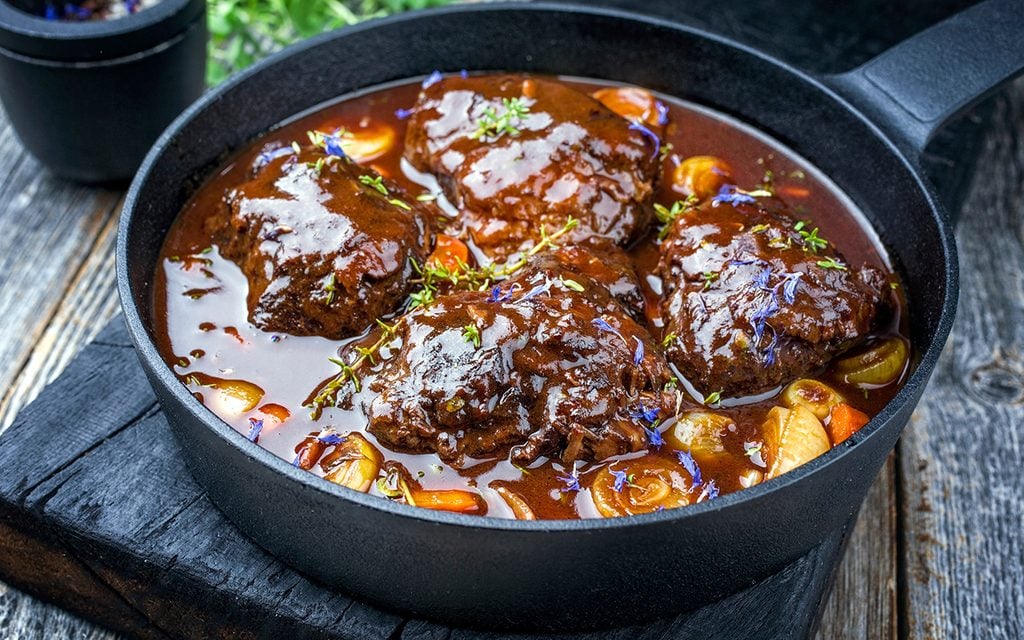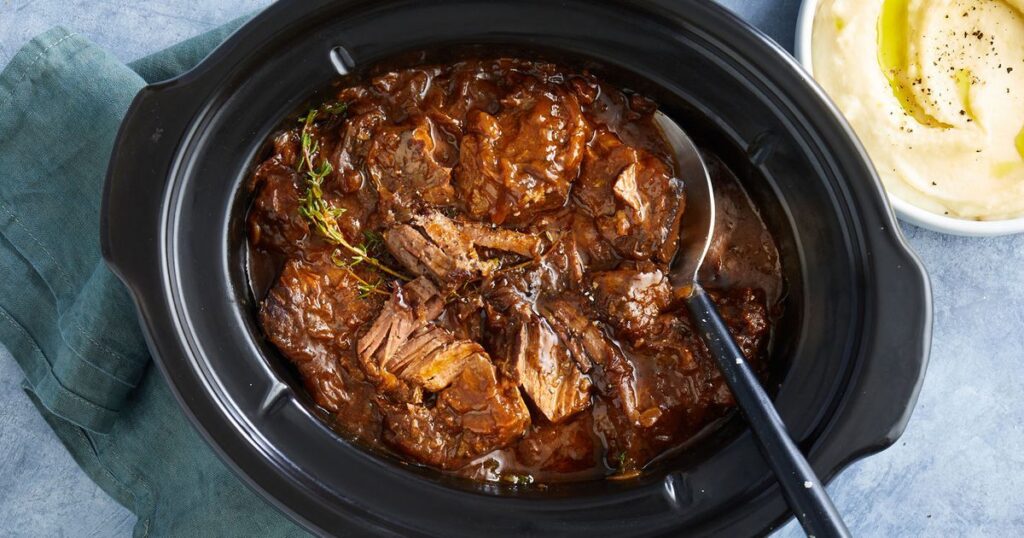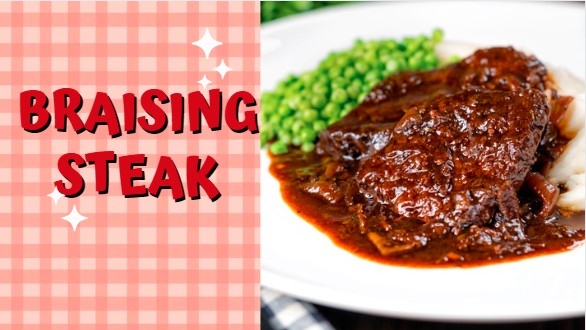Braising steak, often sourced from tougher cuts of meat such as chuck, brisket, or round, epitomizes the transformative power of slow cooking. Unlike steaks meant for grilling or frying, braising steak is perfect for a low-and-slow cooking process that tenderizes the meat over several hours. This method, known as braising, involves initially searing the steak at a high temperature to develop a rich, caramelized crust. Subsequently, the steak is gently simmered in a flavorful liquid—typically a combination of broth, wine, or herbs—which infuses it with deep, robust flavors.

As the fibers in the meat slowly break down, the steak becomes remarkably tender and succulent. Braising steak is a beloved choice in many culinary traditions for hearty dishes like stews and pot roasts, offering a comforting and satisfying meal, especially during the colder months. Its ability to absorb and enhance the surrounding flavors makes it a versatile and indispensable ingredient in the kitchen.
What Is Braising?
Braising is a cooking technique that combines both dry and wet heat methods. It starts with searing the food, usually meat, at a high temperature to create a flavorful crust. Then, the food is slowly cooked in a covered pot with a small amount of liquid, such as broth or wine. This process, conducted at a low temperature, allows tough cuts of meat to become tender and juicy. Braising is ideal for imparting rich, deep flavors and is commonly used for stews and roasts.
What meat is best for braising?
For braising, the best meats are typically those that are tougher and more fibrous, benefiting greatly from the slow cooking process. Cuts like beef chuck, brisket, and short ribs are excellent choices due to their higher connective tissue and fat content, which break down into gelatin to create tender, flavorful dishes. Similarly, pork shoulder and lamb shanks are also superb for braising. These cuts not only become incredibly soft and succulent but also enrich the cooking liquid, enhancing the overall dish.

Ingredients for Braising Steak
Kitchen Tools Needed
How To Cook Braising Steak?
Prepare Your Ingredients
Begin by chopping your vegetables. Peel and slice the carrots, finely chop the onions, and mince the garlic.
Preheat the Pot
Heat your Dutch oven over medium-high heat. Add a couple of tablespoons of olive oil, enough to coat the bottom of the pot.
Sear the Meat
While the oil heats, season the beef chunks generously with salt and black pepper. Once the oil is hot, use tongs to place the beef in the pot. Avoid overcrowding; cook in batches if necessary. Sear each piece until it develops a rich brown crust on all sides, about 2-3 minutes per side. Remove the seared meat and set it aside.
Sauté the Vegetables
In the same pot, reduce the heat to medium. Add the chopped onions and carrots. Sauté them until the onions are translucent and slightly golden, about 5 minutes. Add the minced garlic and sauté for another minute until fragrant.
Deglaze the Pot
Pour in the red wine (if using) or a splash of beef broth. Stir well, scraping up any browned bits from the bottom of the pot. Allow the wine to simmer and reduce slightly, about 3 minutes, enhancing the flavors.
Add Liquids and Seasonings
Return the browned beef to the pot. Stir in the tomato paste until well mixed. Add the remaining beef broth, ensuring the meat is nearly covered. Add the fresh thyme sprigs and bay leaves.
Begin Braising
Bring the liquid to a gentle simmer, then reduce the heat to low. Cover the pot with its lid. Let the beef cook slowly for about 2.5 to 3 hours. The meat should become tender and easy to break apart with a fork.
Finish and Serve
Once the meat is tender, remove the bay leaves and thyme sprigs. Check the seasoning and adjust with additional salt and pepper if needed. The resulting sauce should be thick and flavorful, coating the tender chunks of meat.

What to serve with braising steak?
Tips and Tricks

Variations and Substitutions
Making Ahead, Storage and Reheating
Making Ahead
Storage
Reheating
Some Beef Recipes You Might Like
Delicious Beef With Garlic Sauce Recipe
Perfect Beef Bottom Round Roast Recipe

Frequently Asked Questions – FAQ’s
Braising Steak
Course: MealsCuisine: InternationalDifficulty: easy4
servings20
minutes3
minutes350
kcalIngredients
2 pounds beef chuck, cut into large chunks
2 medium carrots, peeled and sliced
2 small onions, finely chopped
4 cloves garlic, minced
2 cups beef broth
1 cup red wine (optional, substitute with additional broth if preferred)
2 tablespoons tomato paste
2 sprigs fresh thyme
2 bay leaves
Salt and black pepper, to taste
Olive oil, for searing
Directions
- Prepare Your Ingredients:
Begin by chopping your vegetables. Peel and slice the carrots, finely chop the onions, and mince the garlic.
Preheat the Pot:
Heat your Dutch oven over medium-high heat. Add a couple of tablespoons of olive oil, enough to coat the bottom of the pot.
Sear the Meat:
While the oil heats, season the beef chunks generously with salt and black pepper. Once the oil is hot, use tongs to place the beef in the pot. Avoid overcrowding; cook in batches if necessary. Sear each piece until it develops a rich brown crust on all sides, about 2-3 minutes per side. Remove the seared meat and set it aside.
Sauté the Vegetables:
In the same pot, reduce the heat to medium. Add the chopped onions and carrots. Sauté them until the onions are translucent and slightly golden, about 5 minutes. Add the minced garlic and sauté for another minute until fragrant.
Deglaze the Pot:
Pour in the red wine (if using) or a splash of beef broth. Stir well, scraping up any browned bits from the bottom of the pot. Allow the wine to simmer and reduce slightly, about 3 minutes, enhancing the flavors.
Add Liquids and Seasonings:
Return the browned beef to the pot. Stir in the tomato paste until well mixed. Add the remaining beef broth, ensuring the meat is nearly covered. Add the fresh thyme sprigs and bay leaves.
Begin Braising:
Bring the liquid to a gentle simmer, then reduce the heat to low. Cover the pot with its lid. Let the beef cook slowly for about 2.5 to 3 hours. The meat should become tender and easy to break apart with a fork.
Finish and Serve:
Once the meat is tender, remove the bay leaves and thyme sprigs. Check the seasoning and adjust with additional salt and pepper if needed. The resulting sauce should be thick and flavorful, coating the tender chunks of meat.
Serving Suggestions:
Serve the braising steak hot, accompanied by mashed potatoes, polenta, or crusty bread to enjoy the rich sauce.
Conclusion
Braising steak is a culinary technique that truly transforms tougher cuts of beef into succulent, tender meals. By slowly cooking the meat in a flavorful liquid, the tough fibers break down, resulting in a dish that’s both rich and satisfying. This method not only maximizes the taste and texture of less expensive cuts but also infuses them with the deep, layered flavors of the braising liquid. The versatility of braising allows for numerous variations, accommodating a range of tastes and dietary preferences.
Whether enjoyed on a chilly winter evening or as a comforting weekend meal, braising steak offers a rewarding and delicious dining experience. As you master the basics of braising, you can explore different ingredients and techniques to personalize every dish, making each one a unique reflection of your culinary skills and preferences.







